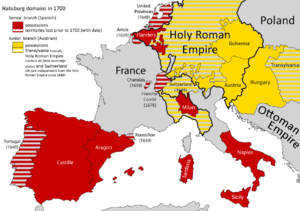| Second Treaty of Partition between England,[a] France and the Dutch Republic [b] | |
|---|---|
 | |
| Context | Voiding of Treaty of The Hague (1698) due to the death of Joseph Ferdinand in February 1699 |
| Signed | 24 March 1700 |
| Location | London and The Hague |
| Parties | |
The Treaty of London (1700) (Dutch: Verdrag van Londen, French: Traités de Londres) or Second Partition Treaty was the second attempt by Louis XIV of France and William III of England to impose a diplomatic solution to the issues that led to the 1701-1714 War of the Spanish Succession. Both divided the Spanish Empire without prior consultation and since the Spanish viewed an undivided Empire as non-negotiable, historians generally view them as largely unenforceable.
Charles II of Spain became the last ruler of Habsburg Spain at the age of five in 1665. He suffered from ill health most of his life and despite marrying twice, by 1698 it was clear he would die without children, leaving the question of his successor unresolved. Although no longer the leading European power, the Empire remained a strong global presence and as the closest heirs were from the Austrian Habsburg and French Bourbon families, acquisition by either would significantly impact the European balance of power.
Hoping to avoid another costly conflict like the Nine Years' War, in 1698 William and Louis agreed the Treaty of The Hague (1698), or First Partition Treaty, making Joseph Ferdinand heir to the Spanish throne. It became redundant when he died of smallpox in February 1699 and the Treaty of London replaced him with Archduke Charles, younger son of Emperor Leopold I. It ultimately failed to prevent the outbreak of war in July 1701.
Cite error: There are <ref group=lower-alpha> tags or {{efn}} templates on this page, but the references will not show without a {{reflist|group=lower-alpha}} template or {{notelist}} template (see the help page).